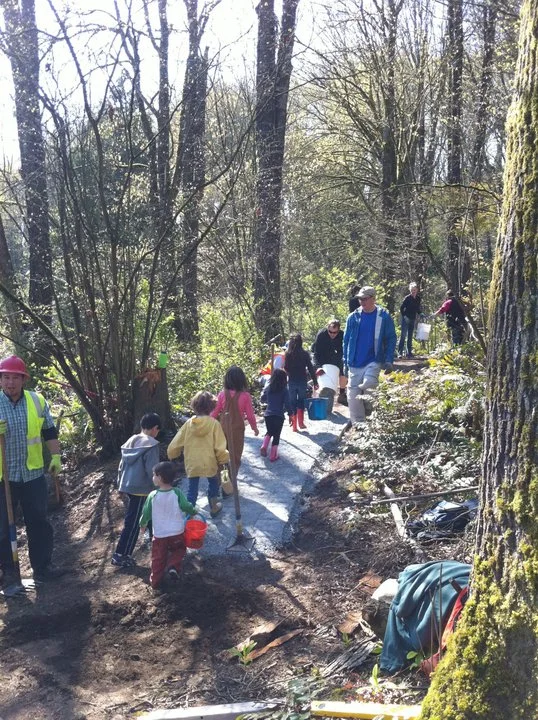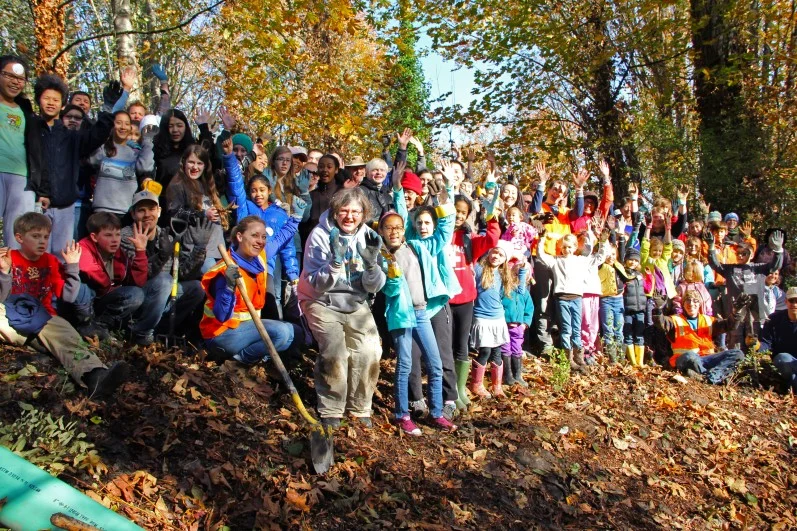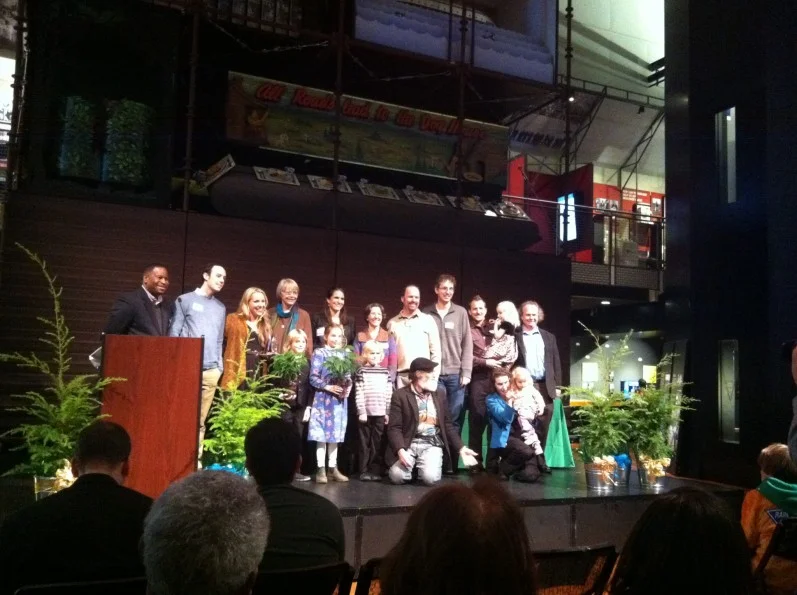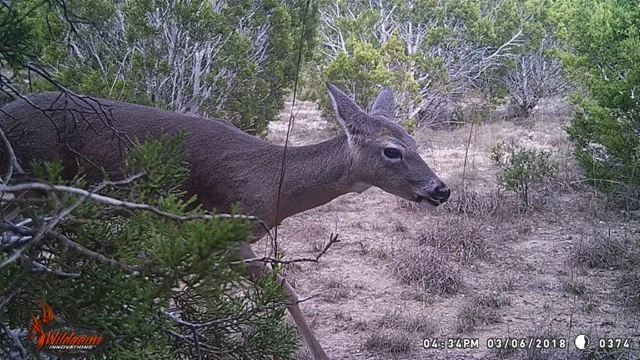Restoring the Land. Restoring Ourselves. (Mary DeJong)
Restoring the Land. Restoring Ourselves.
“The universe is made of stories, not atoms.”
Muriel Rukeyser
Western Trillium (Trillium ovatum)
New life at CheastyGreenspace.
~~
The shocking staccato of a lone M60 unloads into the forest filling the air. A strange-bird-like call answers in response. Tucked amongst the overwhelming English Ivy towers and sharp Himalayan Blackberry walls, strewn mattresses are habitat to both syringes and streetwalkers. The foul odor of feces and rotten food mixes with the residual tang of fornication and fear, layered upon decades of human-dumped garbage and debris. Stolen goods are hidden and found, rerouted through the overgrown invasive underbrush to avoid being spotted. And the bird-like call screeches through the branches and leaves once more. Perched on a muddy knoll with back to the trees and facing the structured, regulated life of the city, sits a lone figure clothed in threadbare layers of mismatched sweaters and socks sending sonorous signals through the air. These are distinct from the now-silent warbles and trills that should be present in this urban forest; these particular shrieks offer an alerting call for those illicitly trading in sex and drugs.
Stay out of these woods, was the explicit message. These woods are scary, bad, and degraded; and we don’t belong there. So fear-filled is this forest that neighboring immigrants and refugees are known to make gestures to ward off the evil eye when they walk on crumbling sidewalks beside the trees’ shadows. So avoided is this forest that neighbors living on opposite sides of the wall-like greenspace maintain veils of social and racial distinction and separation, and go to great lengths to drive around the woods to access neighboring community assets. A fugue-state surrounds this forest; neighbors have chosen to file their fear away into a state of forgetfulness, neglecting this natural world and creating a chasm between the people and a place that could serve to create harmonious, interconnected community.
This is the story of Seattle’s Cheasty Greenspace as it was when my husband and I moved next door to it in 2004. And this was the land that began to call out to me, imploring that I begin to reimagine how this particular place could be restored with a renewed story; how reconciliation with this land held a key to the unity of our community. As I witnessed the hotbed of activity flowing to and through these woods, I wondered how these trees could be experienced without a dominant feeling of fear and separateness. For every stolen vehicle that was left in front of my house, for every ton of garbage and waste that was dumped upon the forest floor, for every red-eyed dealer that understood this landscape could cover his traded addiction, I began to be curious if we could imagine something profoundly different for this space. It was as if the woods began to whisper to me, to call out to me, to summon me to restore an ancient story—one where the dignity of the land and the people were intimately interconnected, where the natural world thrived, and all living things flourished together in harmonious inter-relationship. This urban wild whispered to me of a wholeness, of a restored ecosystem, that could be achieved through equal parts of forest and human restoration. I began to realize that this particular forestscape was a contributing part to the equation that left so many people wondering about the physical and social health disparity of our community—human and more-than-human alike.
Seattle’s Rainier Valley, racially and economically diverse, and historically underserved, has the highest chronic health and crime rates in the city. This area is also an identified “Open Space Gap Area,” meaning a community with no access to open green spaces within a half mile of residences. The irony of a neighborhood where children’s lives are at risk of vehicular hit-and-runs, and gun-shots fill the air more than bird-song, while a massive 43 acres of forest sits within the very midst of this community is glaringly obvious. The inherent connection between holistic human health and the state of this forest demanded my attention. The state of this forest and its ecological well-being began to offer itself as an accompanying answer to the chronic questions around oppression and poverty in our community. The trees offered insight into the well woven roots of injustice and environmental degradation, and how an interrelated relationship with them could inform a sense of being deeply at home both in our particular neighborhood, and subsequently, on our planet. By rewilding this particular place of Living Earth, we would be essentially rewilding ourselves as well.
Ecotheologian and ethicist Larry Rasmussen powerfully posits that “We are not so much at home on earth, as we are home as earth.” The integrity of the natural world renders our most basic and fundamental task: to live in such ways that ensure a flourishing and regenerative life for all of the created world and for all future generations within it. So how we live in our particular places matters as we are meant to be in deep interrelationship with the whole assembly of creation. And how we live in our particular places very much determines whether ecosystems within a bioregion will thrive. Rewilding becomes the process by which we support and live into healthy and whole ongoing relationships within the natural world; I would venture that rewilding becomes a process of returning to a state of belonging, to a state of home. However, we cannot begin to talk about rewilding the Earth, or our particular places, until we begin to rewild our understanding of God. When we begin to engage this sort of divine wholeness, we begin the critical task of rewilding ourselves as well. I believe that through rewilding our bioregional ecosystems, we begin the transformative work of rewilding the image of God.
We carry wildness within. This inner-landscape (what I would call a soulscape) has historically been accessed by stories and myths, and sacred rites and encounters with Mystery. Western civilization has told stories of human separation from the natural world, built upon traditional interpretations of foundational Judaeo Christian scriptures that places humanity hierarchically at the top of the great chain of being, and essentially, God’s vice-regents on earth. Interpretations of scripture such as this has resulted in humanity seeing the natural world as secondary to ourselves, and reducing it to a resource, its value in its commodification and contribution to a Western way of living. This has also resulted in the mental framework that has allowed humanity to extract, denude, deforest, and destruct Earth and her living systems. And, it has resulted in humanity’s own sense of homelessess.
If we are to truly rewild the Earth, we must rewild ourselves and how we see humanity as the image bearer of the Divine; we must bring our sacred stories and our soulscapes back into full and whole relationship with the more-than-human world. Like the presence of the interlacing petals of the Western Trillium (Trillium ovatum), which only grows in restored and rewilded forestscapes, we must see ourselves within an inter-animating relationship with the whole assembly of creation. When we too are rewilded, then our work of ecological restoration within our local bioregions becomes the Great Work of integral becoming and belonging as home as earth.
###
Learn more about Cheasty Greenspace and its wildlife, bike trails, naturalist blog.
Lots to see.
Learn about Mary's rewilding work, products & services at WayMarkers.net.
Check out a recent interview with Mary on rewilding.
###
Writer, eco-theologian, place-maker, pilgrimage-taker Mary De Jong leads transformative religion/ecology work at Waymarkers.net. She also led and manages restoration of the 33 acre, community-owned and restored, Cheasty Greenspace, Visit waymarkers.net to learn about Mary's rewilding opportunities.























